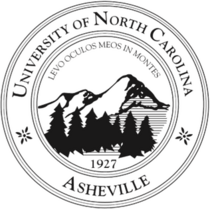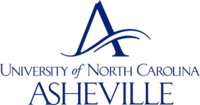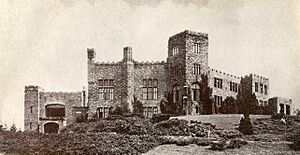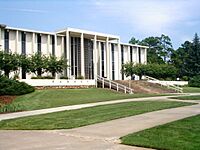University of North Carolina at Asheville facts for kids
 |
|
|
Former names
|
Buncombe County Junior College (1927-1930) College of the City of Asheville (1928-1930) Biltmore Junior College (1930-1934) Biltmore College (1934-1936) Asheville-Biltmore College (1936-1969) |
|---|---|
| Motto | Levo Oculos Meos In Montes (Latin) |
|
Motto in English
|
"I Lift My Eyes to the Mountains" |
| Type | Public liberal arts college |
| Established | September 12, 1927 |
|
Parent institution
|
University of North Carolina |
| Accreditation | SACS |
|
Academic affiliations
|
COPLAC |
| Endowment | $70.4 million (2021) |
| Chancellor | Kimberly van Noort |
|
Academic staff
|
220 (fall 2022) |
| Students | 2,958 (fall 2023) |
| Undergraduates | 2,958 (fall 2023) |
| Location |
,
,
United States
|
| Campus | Small city, 365 acres (1.48 km2) |
| Newspaper | The Blue Banner |
| Colors | Blue and white |
| Nickname | Bulldogs |
|
Sporting affiliations
|
|
| Mascot | Rocky |
 |
|
The University of North Carolina at Asheville (often called UNC Asheville or UNCA) is a public university in Asheville, North Carolina. It is a special type of school called a liberal arts college. This means students learn about many different subjects, like science, art, and history, to get a well-rounded education.
UNC Asheville is part of the larger University of North Carolina system. It is also the headquarters for the Council of Public Liberal Arts Colleges, a group of similar schools across the country.
Contents
History of the University
UNC Asheville started in 1927 as Buncombe County Junior College. It was the first public college in North Carolina that did not charge students money to attend. During the Great Depression, a difficult time for the economy, the school had to start charging tuition.
Over the years, the college changed its name several times. It merged with another school and became Biltmore Junior College, then Biltmore College, and later Asheville-Biltmore College.
In 1949, the college moved to a very cool location: a 20,000-square-foot mansion called Overlook Castle. The castle sat on a mountain and came with 29 acres of land. The college renamed the main building Seely Hall. Today, the castle is no longer part of the university, but it is listed on the National Register of Historic Places.
In 1961, the college moved to its current campus in north Asheville. That same year, it welcomed its first African American student. In 1963, it became a four-year college, meaning students could earn a full bachelor's degree. The school got its current name, UNC Asheville, in 1969 when it joined the University of North Carolina System.
Life on Campus
The university's campus is 365 acres and is located in a small city. It has many interesting places for students to learn and have fun.
- Bob Moog Electric Music Studio: A studio named after Robert Moog, who invented the famous Moog synthesizer. He used to be a professor at the university.
- Botanical Gardens at Asheville: Right next to campus, these gardens have 600 types of plants and beautiful walking trails.
- Kimmel Arena: A large arena that can hold 3,200 people for basketball games and concerts.
- Lookout Observatory: A place where students and the public can use telescopes to look at stars and planets.
- Carol Belk Theatre: A 200-seat theater where students put on plays.
- Historic Earthworks: The campus has preserved mounds of earth that were built during the Civil War Battle of Asheville.
What You Can Study
UNC Asheville offers bachelor's degrees in 36 different subjects, called majors. The most popular majors are biology, business, English, environmental studies, and psychology. Students can also study engineering through a special program with North Carolina State University.
Before graduating, every student must complete a final project, called a capstone. This could be a big research paper or a creative project. Many students get to do research with their professors, and some even study in other countries.
The university is proud that many of its graduates have won Fulbright Fellowships, which are special awards to study or teach abroad.
Professors and Classes
At UNC Asheville, all classes are taught by professors, not by student assistants. Most classes are small, with fewer than 20 students. This means students can get more personal help from their teachers. The student-to-faculty ratio is about 14 to 1.
The Library
The D. Hiden Ramsey Library is at the heart of the campus. It has a Media Design Lab and a special "crAFT Studio" for creative projects using art and technology. The library also has a Special Collections section that keeps important historical documents about Asheville and the surrounding region of Western North Carolina.
Student Activities
There are over 60 clubs and organizations for students to join. These include sports clubs, academic groups, and social clubs.
The Student Government Association (SGA) represents the students. It has a Student Senate and an executive branch led by a student president. There are also groups that support students, like UNCA Out, which is a community for LGBTQ+ students and their friends.
During the summer, the university hosts free outdoor concerts on the campus quad. On Saturdays, a large farmers market called the North Asheville Tailgate Market sets up on campus, where local farmers and artists sell their goods.
UNC Asheville Bulldogs Athletics
The university's sports teams are called the Bulldogs. They compete in NCAA Division I, the highest level of college sports. Most of their teams are part of the Big South Conference. The school colors are royal blue and white.
- Men's sports include: baseball, basketball, cross country, soccer, tennis, and track and field.
- Women's sports include: basketball, cross country, diving, golf, soccer, swimming, tennis, track and field, and volleyball.
Famous People from UNC Asheville
Many successful people have graduated from or worked at UNC Asheville.
Notable Graduates
- Sarah Addison Allen – Best-selling author
- Wiley Cash – Award-winning author
- Wilma Dykeman – Famous writer and environmentalist
- Kenny George – Was the tallest basketball player in NCAA history at 7 feet 7 inches
- Ann B. Ross – Author of the popular Miss Julia book series
- Mike Shildt – Professional baseball manager
- Ty Wigginton – Former professional baseball player
Notable Teachers and Staff
- Richard Chess – Poet and professor
- Robert Moog – Inventor of the Moog synthesizer and a former music professor
- Christopher Oakley – Former Disney animator and professor of new media
- Eddie Biedenbach – Former head basketball coach



